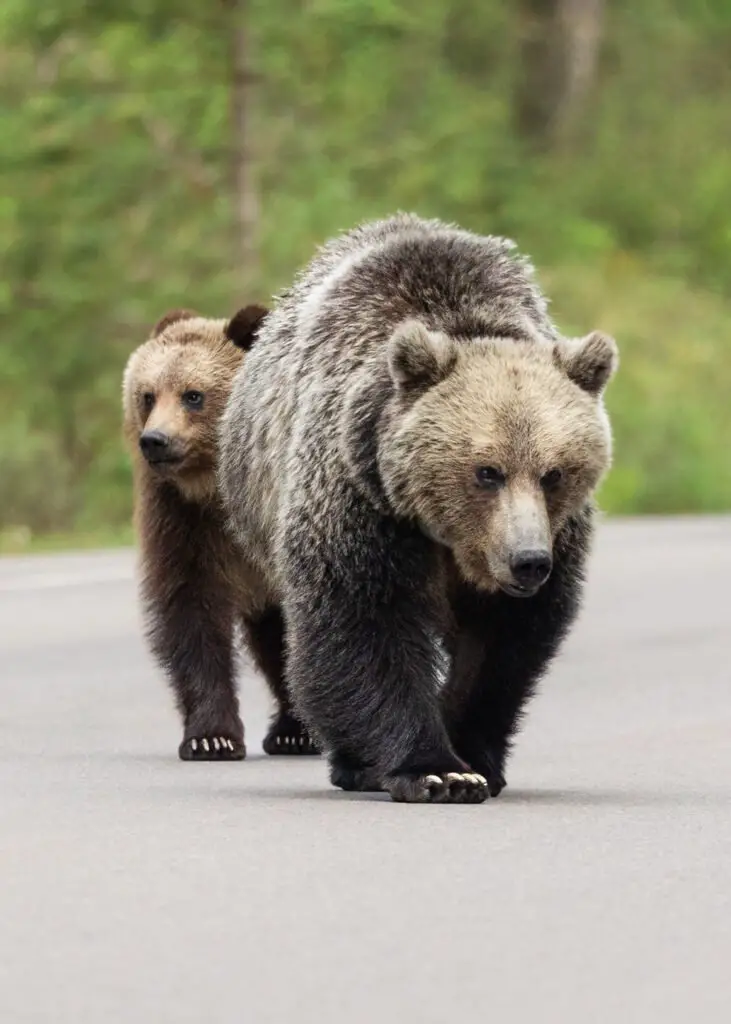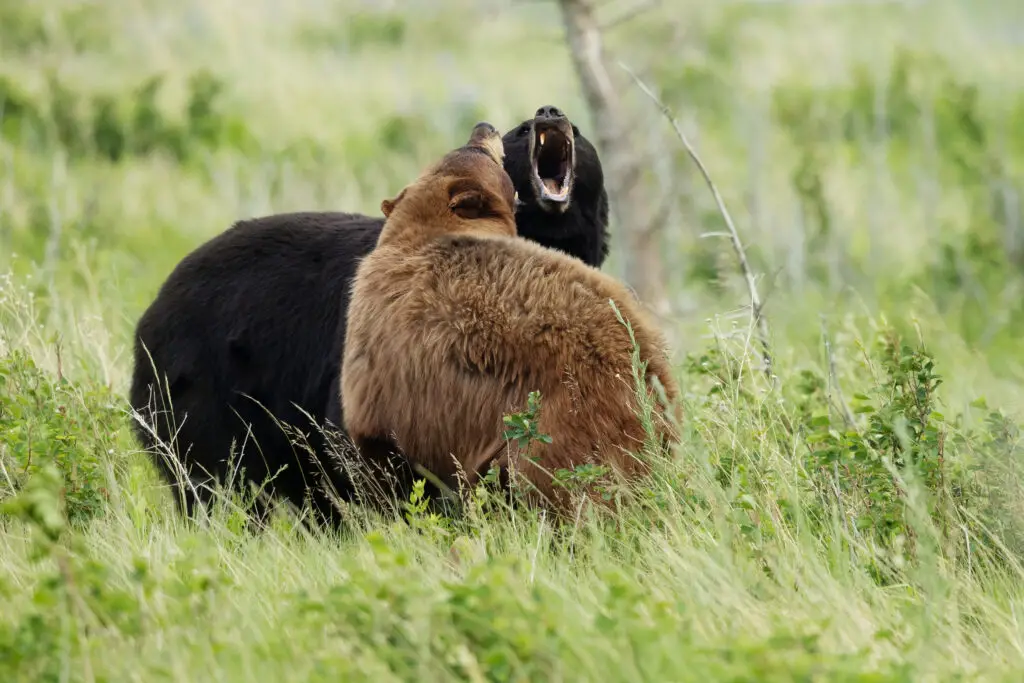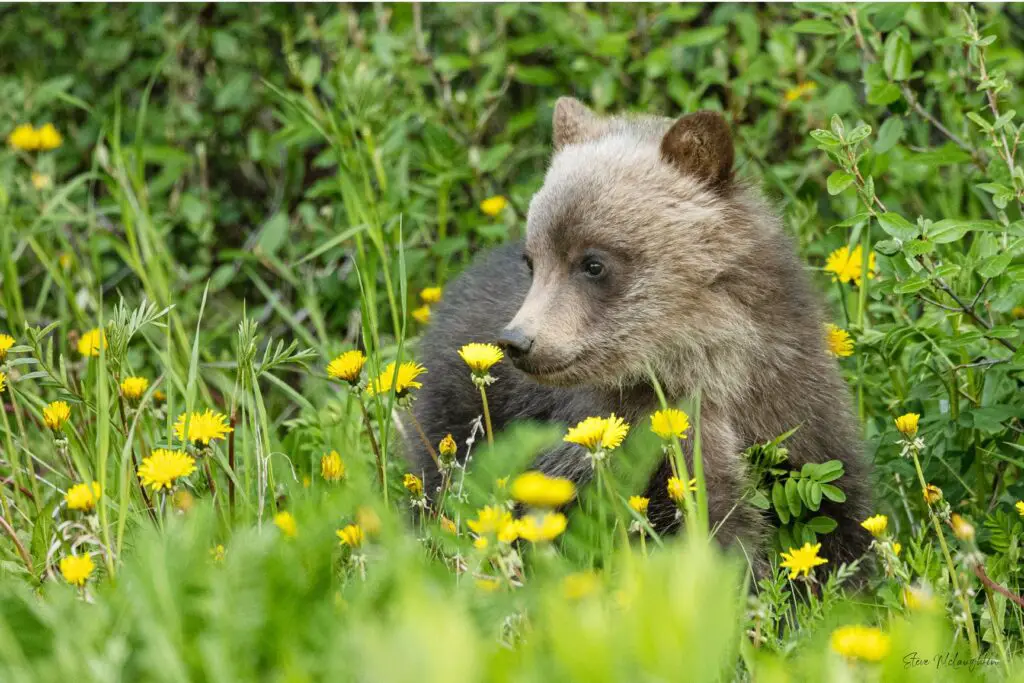On September 29th, a couple and their dog were killed by an aggressive grizzly bear in the back country of Banff. The bear in question was euthanized by a wildlife attack response team. This tragic incident reminds us that we share our Parks with wild animals who act instinctively.
Banff, Jasper and Kananaskis are without a doubt bear country, and it makes sense for bear safety to be at the top of your mind when you visit the Parks.
While you can never fully prevent a bear attack, taking precautions and knowing what to do if you do encounter a bear can greatly influence your odds of walking away unharmed.
The first thing to keep in mind is not to panic, and not to let the fear of bears ruin your trip! Bear attacks are horrible, but they are surprisingly very rare. Many residents and visitors to the region have seen bears from their vehicle and even encountered them on hikes without issue.
Table of Contents
How Common are Bear Attacks?
Hearing about bear attacks can make it seem like bears are really a problem in places like Banff or Jasper.
The truth is that bear attacks are not very common at all. If you consider the number of tourists who visit these Parks each year (over 4.5 million!), and the number of people who live there year round, you’d think that bear attacks would happen all the time but this is not the case.
Still, there is nothing wrong with being bear aware and having a plan in case you do run into one!
When and why do bears attack?

- They are hungry. This is especially a risk in the early spring when they are fresh out of hibernation, or the late fall when they’re fattening up to go into hibernation. Bears spend most of their time foraging for berries, dandelions, fish, and other favorite snacks to put on weight for their winter rest. In years when certain food sources are scarce, bears may venture closer towards civilization which puts everybody at risk.
- They are startled. Bears can act defensively, and even aggressively if they are startled by your sudden presence. Believe it or not, many wild animals will use human hiking trails and paths and it’s not uncommon to come around a corner to see a bear! Travelling in groups, talking loudly and generally making noise while hiking can warn animals about your presence ahead of time, which is actually a good thing.
- They feel threatened. It’s best to never approach a bear on purpose, follow it or corner it. When photographing bears, use a long lens to avoid having to get too physically close to the bear.
- They have young ones nearby. Mother bears are especially a concern when they have cubs nearby. Avoid getting in between a mother bear and her cub(s) as much as possible.
100 meters (300 feet) is a good distance to stay away from bears, especially if you aren’t inside a vehicle. Though they seem slow moving a lot of the time, grizzly bears can charge as fast as 65km/h (40mph) when they want to!
Precautions Against Bear Attacks
Stay on Trails Frequented by Other People
In general, bears tend to avoid areas with lots of people. While there is the odd exception to this rule – in general, you’re much safer when you stay near other people.
Parks will often close trails and post warnings outside of the trail head if bears have recently been spotted in the area. Always pay attention to signage in the area you plan to hike.
You can also check the Parks Canada website for any warnings and trail closures before you head out.
For more photos of grizzly bears, check out our photography gallery!
Some Busier Locations and Hikes
These trails are close to the townsites and well populated with other hikers most times of the year. While these areas aren’t completely immune to bears, any bear sightings are usually reported quickly.
- Tunnel Mountain: A relatively easy mountain hike accessible from Banff without a car
- Sulphur Mountain: A much steeper and more challenging mountain, but you can take the Gondola back down! You can also walk to this hike from Banff
- Marsh Loop: An easy walk that follows the Bow River from the Town of Banff
- Johnston Canyon: A very popular hike that is usually very busy throughout the day. You will need a vehicle to get here as it’s about half an hour from Banff
- Sundance Canyon: A longer (3-4 hour) hike starting from Cave and Basin in Banff
- Sunshine Meadows: An easy summer trail that’s frequented by staff members who keep an eye out for grizzlies. They also offer hosted trail walks here. A 20-minute drive from Banff
- Old Fort Point: A hike you can get to on foot from the Town of Jasper. It is quite steep at certain points but offers some amazing views.
They are all absolutely beautiful hikes and we can definitely recommend them!
Most of the major tourist spots, like Moraine Lake, Lake Louise, Peyto Lake, Maligne Canyon, and other iconic locations are generally very busy for most of the year.

Bears are captivating and powerful animals that can be safely admired from a distance.
Travel in Groups
Especially if you’re planning on visiting longer, less frequented hiking trails and remote locations, bring a group of people with you. 4 or even more people is optimal.
Parks Canada requires that visitors hike in groups of 4 or more for certain trails. Some are busy enough that you can easily find other hikers waiting for a group at the trail head.
If you’re travelling solo and prefer to plan ahead, you can also find hiking buddies in Facebook groups like the Banff and Canmore Hiking Community.
Make Lots of Noise
You might think “I don’t want the bear to know I’m here!” But most of the time, the bear would rather avoid you – especially if you’re making a lot of noise.
Talk loudly with your hiking buddies, especially when going around corners where you could startle a bear. This gives any wildlife in the area plenty of notice that there are people nearby and reduces your chances of startling one.
Keep Dogs on a Leash – Or At Home
Dogs can instigate bear attacks by provoking or even trying to attack the bear. To keep both yourself and your dog safe, be able to control them by keeping them on a leash.
Consider leaving your dog at home or the hotel during longer, more remote hikes.
Carry Bear Spray – and Know How to Use It!
You can buy bear spray from nearly any small shop around Banff. If you’re visiting by plane, you’ll have to buy some after you arrive as it’s not legal to carry bear spray on commercial airplanes. Bear spray isn’t necessary if you plan to stay close to the Town of Banff or Jasper, but it’s a very good idea to keep it on hand if you plan to do any hiking.
Check the expiry date on the cannister. Keep your bear spray accessible at all times when you’re outdoors outside of the town. A bear spray holster on your hip is ideal. You wont be able to access bear spray fast enough from your backpack.
Understand that the bear needs to be close to you (about 4 meters away!) before you can use the bear spray. This can be very nerve wracking, but it ensures that the bear will make contact with the spray.
Staying Bear Safe in the Back Country
If you do plan to visit the back country or to do longer, less crowded hiking trails, we recommend equipping yourself with a Garmin GPS device and/or satellite phone. Much of the back country has no cell service, so you can’t rely on your regular cell phone. While this wont keep you from encountering bears, you can use them to alert someone if you do get into a situation.
Keep Your Distance
Seeing people get too close to bears is a common occurrence in our National Parks. But just because it happens all the time doesn’t mean it’s okay! Bears can seem docile and preoccupied with their snack, for example while grazing on food sources close to the road.
But bears are inherently wild and unpredictable animals, and we should try to keep them that way. When bears become too comfortable and lose their fear of people, it drastically increases the chances that they might wander into town, seek out human food, and act aggressively towards us.
It’s best to keep at least 100 meters (300 feet) from bears at all times. When photographing bears, a telephoto lens is a necessity.
What to Do if You Do Encounter a Bear on Foot
These tips are also useful for other predators like cougars, wolves and coyotes.
- Stay as calm as you can.
- Back away from the bear slowly and leave the area if you can.
- Face the bear the entire time to see whether it’s following you.
- Don’t run. Running can encourage the bear to chase you.
If the bear does approach or follow you:
- If the bear is curious about you, try shouting at it to scare it off.
- Bear spray is your best friend if the bear comes towards you. Try to spray directly into its nose and face.
- Keep in mind that bears can climb trees, so this isn’t a great option for escaping a bear.
If the bear catches up to you:
- Get on the ground with your belly down. Protect your face and neck using your elbows and hands. Unless the bear is truly intent on hunting you, this is usually enough to deter them.
After the encounter:
- If possible, notify someone as soon as you are far enough away.
- Report bear sightings to Parks Canada.

This young bear cub was photographed from a safe distance with a telephoto lens.
Seeing a Bear from Your Vehicle
Seeing a bear from your vehicle is generally safe, but again – try not to crowd around it. “Bear jams” are very common in Banff, Jasper and Kananaskis Country. There are a few different reasons why you still don’t want to get close to bears in your vehicle:
- It could make bears comfortable with being around humans and vehicles, encouraging them to spend more time near towns and campsites.
- It can scare bears away from good food sources along the side of the road. Bears need as much protein as they can get to prepare for hibernation!
- Simply enough – it can create a traffic jam!
If you see bears from your vehicle, admire them from a distance, and don’t stop for too long.
Other Animals to Be Wary of
- Elk – Elk aren’t predators like bears, but they’re still very large, have big antlers and hooves, and can give you a lot of attitude if you get too close. Elk like to hang out close to towns where they feel safer from predators like bears. Elk are larger than deer, and about the size of a horse. Be especially cautious of elk during September and October, which is their rutting season.
- Coyotes – coyotes are about the size of an average dog, and can even look like a dog from far away. It’s not unusual to see coyotes even in Town. These animals rarely hunt humans, but they can be nasty to dogs. You should still avoid approaching them or getting too close.
- Cougars – cougar attacks on humans are extremely rare. In fact, it’s pretty uncommon to even see a cougar. But of course if you do – avoid!
Conclusion
It’s good to have a healthy amount of fear about bears. They are large, wild and can be dangerous predators.
But don’t let that ruin your enjoyment of the Park. Bear attacks are rare, and equipping yourself with the right tools and knowledge, you can protect yourself.
Have fun traveling the Rockies and stay bear safe!
